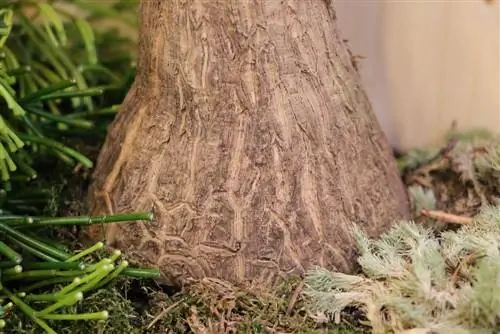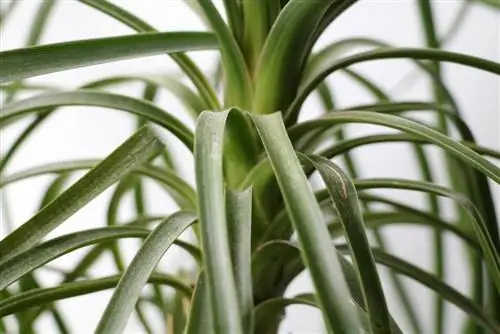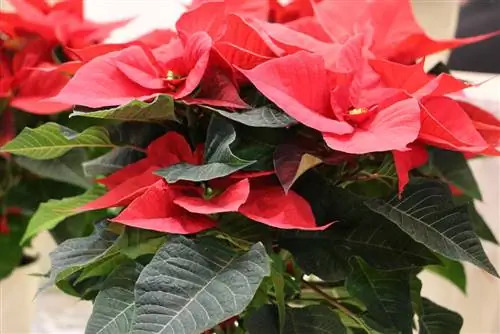- Author admin [email protected].
- Public 2023-12-17 03:39.
- Last modified 2025-01-24 12:45.
The elephant foot (botanically Beaucarnea recurvata) is a succulent tree native to the tropical and dry forests of Mexico. Due to its bizarre appearance with the trunk that is only thickened at the base and the thin and drooping leaves that are up to 180 centimeters long, it is one of the most popular houseplants in German living rooms. However, parents and pet owners should be careful because the asparagus plant is poisonous.
Botanical classification
The German common name 'elephant foot' is used for two different, very similar plants: 'Beaucarnea recurvata' and 'Beaucarnea stricta'. The popular houseplant belongs to the asparagus family (Asparagaceae) and is distantly related to the palm lilies, which are also often cultivated in the home and garden. The indoor tree is sometimes also referred to as a 'bottle tree', but this can lead to a dangerous confusion. In contrast to 'Beaucarnea recurvata', the Australian bottle tree or lucky tree of the same name (Brachychiton rupestris) is non-poisonous.
Elephant foot is poisonous to small children and pets
Due to the same common name, you should carefully check which 'bottle tree' it actually is when purchasing. Since all parts of the elephant foot contain saponins, these can lead to severe symptoms of poisoning if consumed by small children or pets. However, the plant is not considered to be highly poisonous, but it can cause extremely unpleasant symptoms in humans and animals - these become more pronounced the smaller the child orthe animal is. Adults would generally have to eat very large quantities of the plant in order to develop the corresponding symptoms.
The elephant foot is poisonous to:
- Babies and small children
- Cats
- Dogs
- Budgies and other birds
- Rabbits and guinea pigs
- as well as other pets (such as mice, rats or hamsters)
Always place the elephant foot out of the reach of children and animals

Among others, the renowned Institute for Veterinary Pharmacology and Toxicology in Zurich and the no less respectable information center against poisoning at the University Hospital of Bonn certify the toxicity of elephant foot for children and pets and recommend that the plant be placed out of their reach. Both children and animals can be supervised around the clock, but out of curiosity they like to try the houseplants in an unobserved moment. For this reason, parents and pet owners should err on the side of caution and either avoid using the elephant foot as a room decoration or place it in a location where neither children nor animals have access.
What are saponins?
The toxicity of elephant foot is caused by the saponins it contains, which are found in many plants as a natural fungicide and antibiotic. Legumes such as peas, asparagus and spinach contain saponins, but the highest concentrations are found in typical desert plants - which also includes elephant foot. In small doses, these plant substances are used in medicine, but in higher concentrations they can cause inflammation or even tissue damage. They also have a hemolytic effect, meaning they can break down the blood into its components and must therefore not enter the bloodstream under any circumstances.
Tip:
The blood-dissolving effect of saponins is particularly important if you have cut yourself on the sharp leaves of the elephant foot - the wound should be thoroughly cleaned immediately under running water. Otherwise it can become seriously infected. When handling (e.g. pruning) the plant, it is also advisable to wear sturdy gloves.
Signs of poisoning
If the child or pet has eaten something from elephant foot - cats, for example, like to nibble on the tips of the leaves - poisoning is noticeable through various symptoms. Initially, you will feel unwell, perhaps accompanied by dizziness and nausea as well as sudden fatigue. Abdominal pain, cramps and visual disturbances are also typical. Later, vomiting may occur, with blood often being spit out. If the plant sap comes into contact with the skin orOpen wounds can cause skin irritation and even purulent inflammation.
First aid measures in case of poisoning
Do not make your child or animal vomit under any circumstances, as this can only make the symptoms of poisoning worse. Instead, the person affected should drink as much still water as possible to flush out the toxins. Do not give milk to drink: contrary to popular belief, it does not neutralize the poison. Keep calm and consult a doctor or veterinarian. If known, you can also contact the local poison control center in your area.






